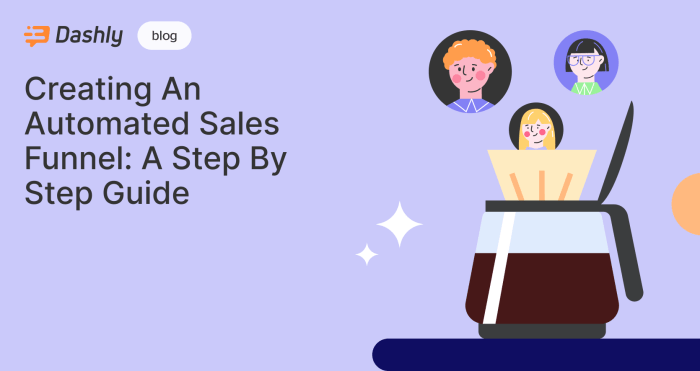Creating an Automated Sales Funnel takes center stage, drawing you into a world of business optimization and growth. Get ready to dive into the realm of automated sales strategies that are revolutionizing the industry.
In this guide, we’ll explore the importance of automated sales funnels, designing effective strategies, implementing automation in sales processes, and tracking performance for optimal results.
Importance of Automated Sales Funnels
Automated sales funnels play a crucial role in the success of businesses today. These automated systems help streamline the sales process, increase efficiency, and drive more revenue for companies.
Benefits of Automated Sales Funnels
- Increased Efficiency: Automated sales funnels allow businesses to reach out to potential customers at the right time with personalized messages, leading to higher conversion rates.
- Time-Saving: By automating repetitive tasks such as sending follow-up emails or reminders, businesses can focus on more strategic aspects of sales and marketing.
- Improved Lead Nurturing: Automated sales funnels enable businesses to nurture leads through targeted content and communication, ultimately building stronger relationships with customers.
Examples of Successful Businesses
Many successful businesses have effectively implemented automated sales funnels to drive growth and increase sales. One notable example is Company X, which saw a 30% increase in sales within the first month of implementing an automated sales funnel system. Another example is Company Y, which reduced their sales cycle by 50% after integrating automated processes into their sales strategy.
Designing an Automated Sales FunneL

When it comes to designing an effective automated sales funnel, there are several key steps that you need to follow in order to maximize your results and increase your conversions. Let’s dive into the process of creating a successful automated sales funnel.
Key Components of an Automated Sales Funnel
- Lead Magnet: Offer a valuable resource or content in exchange for contact information to generate leads.
- Landing Page: Create a high-converting landing page to capture leads and guide them through the funnel.
- Email Sequences: Develop automated email sequences to nurture leads and move them towards a purchase.
- Sales Page: Design a compelling sales page that highlights the benefits of your product or service and encourages conversions.
- Upsell/Cross-sell Offers: Implement additional offers to maximize customer value and increase sales revenue.
Comparison of Automation Tools for Sales Funnels
When it comes to choosing the right automation tool for your sales funnel, it’s essential to consider factors like ease of use, integration capabilities, and pricing.
| Automation Tool | Key Features | Pricing |
|---|---|---|
| ClickFunnels | Drag-and-drop funnel builder, email marketing automation, membership site creation | Starts at $97 per month |
| ActiveCampaign | Advanced email marketing, CRM integration, marketing automation workflows | Starts at $9 per month |
| Kartra | All-in-one marketing platform, funnel builder, email automation, membership sites | Starts at $99 per month |
Implementing Automation in Sales Processes: Creating An Automated Sales Funnel

Automation in sales processes can greatly streamline operations within a business, allowing for more efficient and effective customer interactions. By automating repetitive tasks, businesses can free up time for their sales teams to focus on building relationships and closing deals. This can lead to increased productivity and ultimately, higher revenue.
Areas for Automation in Sales Processes, Creating an Automated Sales Funnel
- Lead Management: Automation can help in tracking and managing leads more effectively, ensuring that no potential customer falls through the cracks.
- Email Marketing: Automated email campaigns can be set up to nurture leads and keep customers engaged throughout the sales process.
- Follow-up: Automating follow-up tasks can ensure that no opportunity is missed and that customers receive timely responses to their inquiries.
- Data Entry: Automating data entry tasks can reduce errors and free up time for sales reps to focus on more strategic activities.
Tips for Integrating Automation into Sales Strategies
- Define Clear Goals: Before implementing automation, it’s important to clearly define your sales goals and objectives to ensure that automation aligns with your overall strategy.
- Choose the Right Tools: Select automation tools that are user-friendly, integrate well with your existing systems, and offer the features you need to streamline your sales processes.
- Train Your Team: Provide training to your sales team on how to effectively use the automation tools to maximize their efficiency and effectiveness in their roles.
- Monitor and Measure: Regularly monitor the performance of your automated sales processes and make adjustments as needed to optimize results and drive continuous improvement.
Tracking and Analyzing Sales Funnel Performance
Tracking and analyzing the performance of automated sales funnels is crucial for optimizing your sales processes and improving conversion rates. By closely monitoring key metrics and analyzing data, businesses can make informed decisions to enhance their overall sales funnel efficiency.
Key Metrics for Monitoring Sales Funnel Performance
- Conversion Rate: This metric indicates the percentage of leads that progress through each stage of the sales funnel and ultimately make a purchase.
- Lead Velocity: Tracking the rate at which leads are entering the sales funnel can help predict future revenue and identify potential bottlenecks.
- Customer Acquisition Cost (CAC): Calculating how much it costs to acquire a new customer compared to the revenue generated can provide insights into the effectiveness of your sales funnel.
- Churn Rate: Monitoring the rate at which customers drop off at each stage of the funnel can highlight areas that need improvement to retain customers.
Making Data-Driven Decisions from Sales Funnel Analytics
Once you have gathered data from your automated sales funnel, it’s essential to analyze the insights to make data-driven decisions. By leveraging the information obtained, businesses can identify trends, optimize processes, and implement targeted strategies to enhance overall performance.